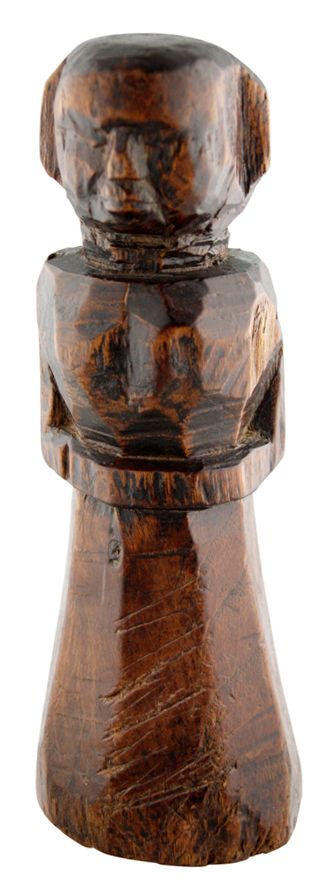 I don’t usually buy wooden things, but I always pick up and look at things that catch my eye, regardless of what they are made of, or even are. There’s always something new to learn.
I don’t usually buy wooden things, but I always pick up and look at things that catch my eye, regardless of what they are made of, or even are. There’s always something new to learn.
Last time I went to the excellent antiques centres at Sawbridgeworth in Essex, I found this rather stern looking lady in the Herts & Essex Antiques Centre, priced at £15. Roughly hewn from from wood, she had a certain naive and primitive charm that said something to me. She also had a very good level of wear and a great patina, indicating that she had some age and had been handled a fair bit. You could say that my rough lady had been around the block a few times…
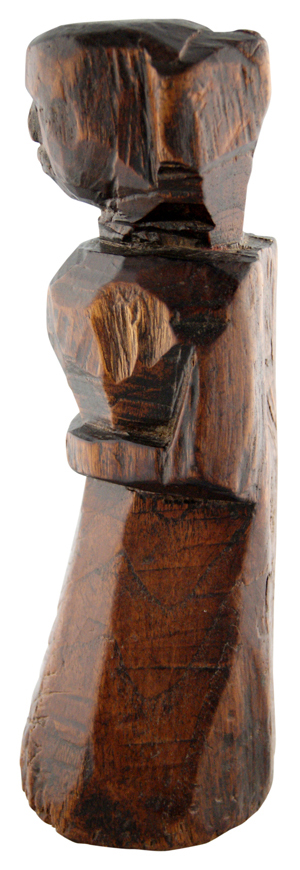 As the Victorian period saw many revivals, and the production of furniture and objects in much earlier styles dating from the 16th century onwards, I thought she might have been made in Europe, maybe Britain, sometime during the 19th century. Perhaps as something that looked like it had been made in the Medieval, Tudor or Jacobean periods. But something didn’t seem quite right in my mind…so I asked some friends.
As the Victorian period saw many revivals, and the production of furniture and objects in much earlier styles dating from the 16th century onwards, I thought she might have been made in Europe, maybe Britain, sometime during the 19th century. Perhaps as something that looked like it had been made in the Medieval, Tudor or Jacobean periods. But something didn’t seem quite right in my mind…so I asked some friends.
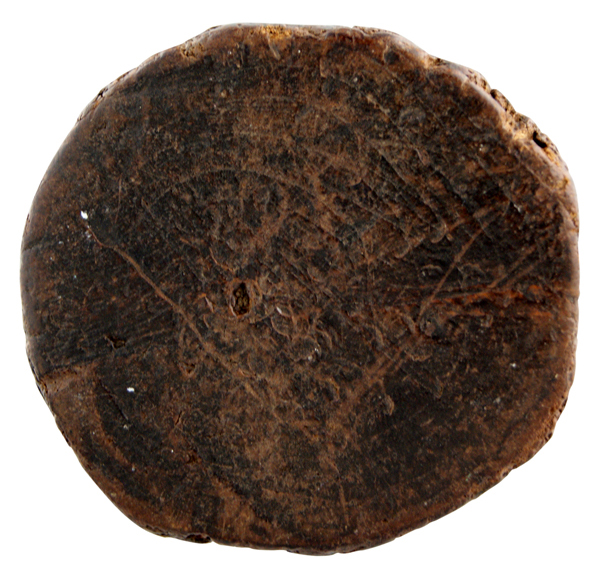 My opinion was shared by most people I asked, including the fact that something didn’t sit quite right. One person suggested that she was a volva effigy – effectively a representation of a Scandinavian witch. Some dated her to the 18th century (exciting!), and the friendly and widely respected dealer Kate Thurlow thought that she was vaguely reminiscent of the work of the later sculptor Ernst Barlach, even though he obviously didn’t carve her. All agreed that she wasn’t a child’s doll, she wasn’t cut from anything larger like a piece of furniture, she wasn’t part of something like a grouping, and that she wasn’t a finial. But what was she?
My opinion was shared by most people I asked, including the fact that something didn’t sit quite right. One person suggested that she was a volva effigy – effectively a representation of a Scandinavian witch. Some dated her to the 18th century (exciting!), and the friendly and widely respected dealer Kate Thurlow thought that she was vaguely reminiscent of the work of the later sculptor Ernst Barlach, even though he obviously didn’t carve her. All agreed that she wasn’t a child’s doll, she wasn’t cut from anything larger like a piece of furniture, she wasn’t part of something like a grouping, and that she wasn’t a finial. But what was she?
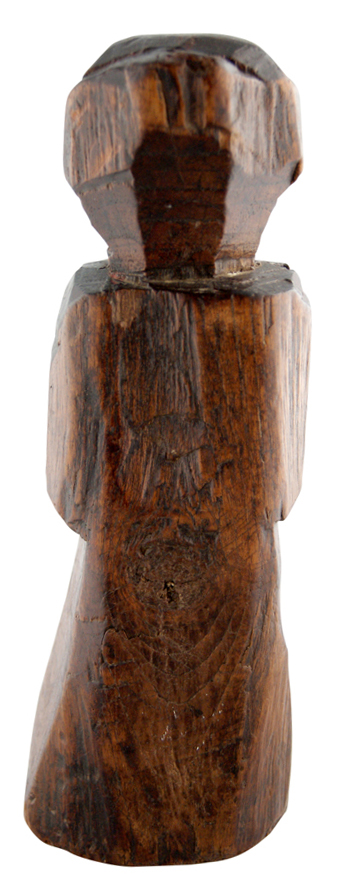 Everyone suggested I spoke to folk art über-dealer and specialist Robert Young, who I had thankfully met at an Antiques Young Guns event a few months before. As expected, he knew exactly what she was. So let’s spin that globe and switch countries – from somewhere in Europe all the way down to India. He identified her as a wooden ‘doll’ (for want of a better word) made in India some time from the early to mid 19th century. Features that revealed this included:
Everyone suggested I spoke to folk art über-dealer and specialist Robert Young, who I had thankfully met at an Antiques Young Guns event a few months before. As expected, he knew exactly what she was. So let’s spin that globe and switch countries – from somewhere in Europe all the way down to India. He identified her as a wooden ‘doll’ (for want of a better word) made in India some time from the early to mid 19th century. Features that revealed this included:
- The faceted, tapered ‘skirt’ she wears
- The folded arms
- The use of a hardwood that looks like, but isn’t, walnut
- A heavy patina that shows she has been handled frequently
- A size of around 8 inches (20cm) high.
Pretty conclusive, really. Robert went on to say that mine was more primitively carved than many examples he’s seen before, and has less detail and shorter hair. He was unable to explain the series of strange cut marks on her skirt, but said that many of the others he has seen have the same marks. Maybe you know? Was she used for winding something (like yarn) which was then cut?
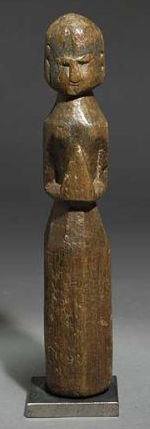 Armed with this exciting information, I indulged in some further research. It transpires that these ‘dolls’ were made in Gujarat, an area known for its wood carving, during the 19th century and early 20th century. Another example is shown on the right. Produced in rural carving communities known as mewara mistris, they were usually given to brides as wedding gifts, perhaps as fertility symbols. They were quite commonly found around 30 years ago, but supplies have dried up and they tend to fetch around £100 today. The example shown here was listed on eBay for that.
Armed with this exciting information, I indulged in some further research. It transpires that these ‘dolls’ were made in Gujarat, an area known for its wood carving, during the 19th century and early 20th century. Another example is shown on the right. Produced in rural carving communities known as mewara mistris, they were usually given to brides as wedding gifts, perhaps as fertility symbols. They were quite commonly found around 30 years ago, but supplies have dried up and they tend to fetch around £100 today. The example shown here was listed on eBay for that.
But the value doesn’t matter. Robert noted her “genuine charm” and, for me, that’s one of the two reasons why I bought her. The other reason is the journey – the journey of learning something new. And, of course, the journey from Georgian England to a 19th century wedding in Gujarat, Northern India.
Thank you to Robert Young, Kate Thurlow and Caroline Joy Watson for their kind and freely-given help and advice when compiling this post.

